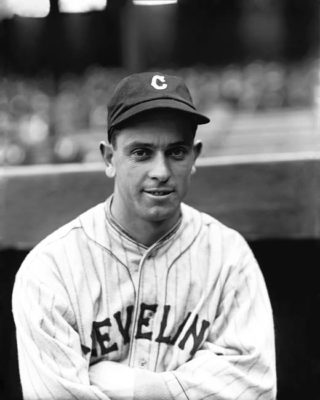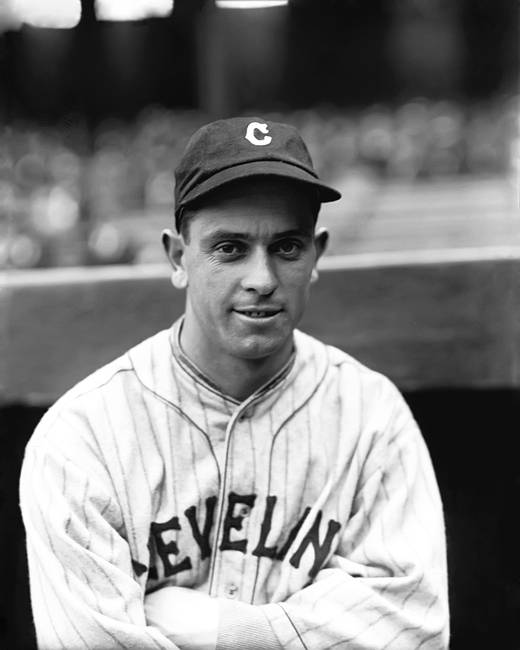The Baseball Father and Son Earl and Earl D. Averill Photo Gallery
Click on any image below to see photos in full size and to start Photo Gallery:

We’re Contacted by a Descendant of Hall-of-Famer, Earl Averill!
“Earl Averill supports my contention that you don’t have to be a muscle-bound giant to be a great major league hitter. Averill [who was only 5′ 9″] was treated with the kind of respect usually reserved for imposing specimens like Foxx and Gehrig.” -Ted Williams
We love it when we’re contacted by relatives of former major leaguers, but it’s rare when the person is a relative of TWO major leaguers. And not only that, in this case, one of them is a Hall-of-Famer!
One of our readers, Brad Averill, is the great-grandson of the Indians’ Hall-of-Fame center fielder Earl Averill. As many of you will remember, Earl had a son, Earl D. Averill, who also played in the majors, and was Brad’s great uncle. Brad doesn’t remember his great-grandfather, who passed away in 1983, but does remember his great uncle Earl D. Averill who played in the majors from 1956-1963. He was a catcher for the Cubs, White Sox, Angels, Phillies, and Indians, hitting .242 with 249 hits and 44 home runs.
One thing Brad remembers is that Uncle Earl had huge hands, and could pick up five baseballs with one hand. Brad added: “I have a picture of Uncle Earl holding my older brother straight up in the air by his feet and balancing him. He always had a smile on his face. He loved to fish and he loved baseball and everything it stood for.” After baseball, Earl D. Averill ran an upholstery business out of his Auburn, Oregon home with his wife Pat. He passed away recently in 2015.
His father, Hall-of-Famer Earl Averill, known as “The Earl of Snohomish,” played 13 seasons in the majors (1929-41) for the Indians (1929-39), Tigers (1939-40), and Braves (1941). Over his career the six-time All-Star posted a .318 average, with 2019 hits, 1224 runs, 401 doubles, 238 home runs, 1164 RBIs, .395 on-base percentage, and .534 slugging average. Averill batted .300 eight times, scored 100 runs nine times, and drove in 100 or more runs in five seasons. He was the only American League outfielder named to the first six All-Star teams (1933-38). In over ten years with the Indians, he remains their all-time leader in runs, RBIs, triples, and total bases. He’s third on the Indians all-time list for hits and doubles; and fourth in home runs and walks. His uniform #3 has been retired by the Indians.
Earl Averill got a late start in the majors, breaking in with the Indians in 1929 just a month short of his 27th birthday. He immediately became their starting center fielder. He homered in his first major league at-bat (April 16, 1929), and hit .332 his rookie year. He didn’t have a great arm, but he played solid defense and led American League outfielders in putouts. During his era, he developed into one of the major leagues’ best hitters.
In 1930 Averill followed up his brilliant rookie year by batting .339 and driving in 119 runs. On September, 17, 1930, the compact, 5”9” slugger hit three homeruns in the first game of a doubleheader and added another one in the nightcap, becoming the first major leaguer to homer four times in a twin bill. In that same doubleheader he knocked in a still-existing American League record 11 runs. In 1931, Averill slammed career highs of 32 home runs, 209 hits, 140 runs, and 143 RBI’s. He again hit 32 home runs in 1932, and the Red Sox showed him the ultimate respect that year by walking him five consecutive times in a game.
Averill led the American League in hits (232) and triples (15) in 1936, and posted a .378 batting average, but finished second to Luke Appling’s .388. In the 1937 All-Star game, Averill is remembered for hitting the line drive that broke Dizzy Dean’s toe, eventually causing Dean to develop a sore arm and shortening his career. He hit .330 in 1938, but started 1939 in a slump. The Indians dealt the fan-favorite Averill to the Tigers two months into the season.
As a part-time player for the Tigers, he contributed to their pennant winning season of 1940; and made pinch-hitting appearances in the World Series. Averill’s playing days ended after a brief stop with the National League’s Boston Braves in 1941. He was inducted into the Hall of Fame in 1975.
Brad Averill says his youngest son also loves baseball and “has the Averill baseball talent. Maybe one day I’ll see his photos here on Old-Time Baseball Photos!”
Well, Brad…With your son being well-stocked with those Averill genes, there’s a good chance that just might happen. Be sure to keep us posted on his progress!
Gary Livacari
Photo Credits: All from Google search; Colorization by Don Stokes:https://www.facebook.com/Don-Stokes-Old-Time-Baseball-Colorizations-923346241033508/?fref=ts; Other photos found on Google search
Information: Excerpts edited from the Earl Averill Wikipedia page.
Statistics from Baseball Reference, Earl Averill page
Subscribe to my blog for automatic updates and Free Bonus Reports: “Memorable World Series Moments” and “Gary’s Handy Dandy World Series Reference Guide.”

